National Day of the Republic of China
| National Day of the Republic of China | |
|---|---|
 A symbol often seen during Double Ten Day (it is the combination of two characters for "10" (十) | |
| Also called | Double Tenth Day, Double Ten Day |
| Observed by |
|
| Type | Historical, cultural, nationalist |
| Celebrations | festivities, including fireworks and concerts |
| Date | October 10 |
| Next time | 10 October 2017 |
| Frequency | annual |
The National Day of Taiwan, the Republic of China (Chinese: 國慶日; pinyin: Guóqìng Rì; Zhuyin Fuhao: ㄍㄨㄛˊ ㄑㄧㄥˋ ㄖˋ[1]), also referred to as Double Ten Day or Double Tenth Day[2] (Chinese: 雙十節; pinyin: Shuāngshíjié; Zhuyin Fuhao: ㄕㄨㄤˉ ㄕˊ ㄐㄧㄝˊ), is the national day of the Republic of China (ROC). It commemorates the start of the Wuchang Uprising of October 10, 1911 (10-10 or double ten), which led to the collapse of the Qing Dynasty in China and establishment of the ROC on January 1, 1912.
As a result of the Chinese Civil War, the government of the Republic of China lost control of mainland China and relocated to Taiwan in December 1949. National Day is now mainly celebrated in Taiwan, but is also celebrated by some overseas Chinese.
Celebration in Taiwan

During the establishment of the ROC, Taiwan was under Japanese rule, which began in 1895. In 1945, after surrender of the Empire of Japan in World War II, Taiwan was placed under the control of the ROC.
In Taiwan, the official celebration begins with the raising of the flag of the Republic of China in front of the Presidential Building, along with a public singing of the National Anthem of the Republic of China. It is then followed by celebrations in front of the Presidential Building; from time to time, a military parade may occur. Festivities also include many aspects of traditional Chinese and/or Taiwanese culture, such as the lion dance and drum teams, and cultural features coming from Taiwanese aborigines are integrated into the display in recent years. Later in the day, the President of the Republic of China would address the country and fireworks displays are held throughout the major cities of the island. In 2009, all government sponsored festivities for the Double Ten Day were cancelled, and the money intended for the festivals (NT$ 70 million) were reallocated for reconstruction of the damage done by Typhoon Morakot.
National Day Military Parade



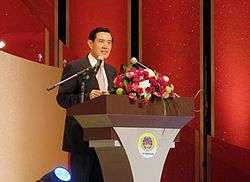
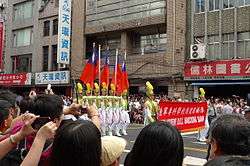
In the past, the Republic of China Armed Forces has traditionally put on a military parade. During this parade, troops and equipment are marched past a reviewing platform in front of the Presidential Building. Typically, foreign ambassadors, military officers, and other representatives and dignitaries are invited to view the parade.
The parade has been held intermittently during the period of the Republic of China on Taiwan. The military parade on October 10, 1949 was the first public military parade held in Taiwan with Chen Cheng serving as the Grand Review Officer. The 1964 National Day parade was struck by tragedy when a low flying airforce F-104 Starfighter fighter aircraft struck a Broadcasting Corporation of China tower, causing the plane's fuel tank to fall and kill three people including a woman and her baby in front of the Central Weather Bureau building in downtown Taipei. The other two remaining F-104 aircraft were ordered to look for the crashed aircraft and accidentally collided and crashed in Tucheng City, Taipei County (now New Taipei City) killing both pilots. The parade was not held again until 1971 (the 60th anniversary), while the mobile column and flypast segments returned in 1975. When Chen Shui-bian became President, the parade was not held until 2007 and then it was entitled a "Celebration Drill" and not a traditional military parade. Since Ma Ying-jeou became president, one parade has been held on the centenary celebrations of the Double Tenth Day.
The tradition of shouting Long Live the Republic of China!( "Zhonghua Mingguo Wansui!" (中华民国万岁))at the end of the addresses of the President of the Republic of China was not held for the first time in 2016, also the very year that fire and police services joined the parade for the first time in history breaking a tradition of a purely military parade to include personnel from civil uniformed services.
List of Republic of China National Day Parades
| Parade Year | Exercise Name | Grand Review Officer | Venue | Parade Commander | Number of Troops | Remarks |
|---|---|---|---|---|---|---|
| 2016 | Tsai Ing-wen | Taipei | 2,500+ | |||
| 2011 | Ma Ying-jeou | Taipei | 1,000+ | The centennial event featured a skydiving show of 12 paratroopers of the Army Airborne Training Center above the plaza in front of the Presidential Office.[3] Military parade involving 1,000+ personnel, 71 aircraft and 168 vehicles.[4] On the part of the ground troops only the ROCAF Honor Guard Battalion and the ROCAF Composite Headquarters Band joined the parade on behalf of the armed forces. | ||
| 2007 | 同慶操演 | Chen Shui-bian | Taipei | Wu Sihuai | 3,000 | Exhibitions presented on national defense, non-traditional military parade |
| 1991 | 華統演習 | Lee Teng-hui | Taipei | Ro Wenshan | 12,566 | ROC Eightieth Anniversary |
| 1988 | 光武演習 | Lee Teng-hui | Taipei | Chen Tingchong | 13,166 | ROC Seventy-Seventh Anniversary |
| 1987 | Chiang Ching-kuo | Taipei | It was the last military parade held during Chiang Ching-kuo's administration. It was held on October 11, the day after the Double Ten Day celebrations due to Chiang's ailing condition. (Also the first since the abolition of Martial Law in Taiwan earlier that July.) | |||
| 1986 | Chiang Ching-kuo | Taipei | ROC Seventy-Fifth Anniversary (Diamond Jubilee) | |||
| 1982 | Chiang Ching-kuo | Taipei | ||||
| 1981 | 漢武演習 | Chiang Ching-kuo | Taipei | Hsu Li-nung | 11,966 | ROC Seventieth Anniversary |
| 1980 | Chiang Ching-kuo | Taipei | ||||
| 1978 | 漢威演習 | Chiang Ching-kuo | Taipei | Chiang Chung-ling | ||
| 1975 | 大漢演習 | Yen Chia-kan | Taipei | Zhang Jiajun | ||
| 1964 | 興漢演習 | Chiang Kai-shek | Taipei | Hau Pei-tsun | Two F-104 aircraft collided after an air formation, killing both pilots | |
| 1963 | 復漢演習 | Chiang Kai-shek | Taipei | Yuan Guo-Zheng | 15,370 | |
| 1961 | 復興演習 | Chiang Kai-shek | Taipei | Cheng Wei-yuan | ROC Fiftieth Anniversary (Golden Jubilee) | |
| 1960 | 鼎興演習 | Chiang Kai-shek | Taipei | Chu Yuan-Cong | ||
| 1957 | 中興演習 | Chiang Kai-shek | Taipei | Hu Xin | 12,000 | |
| 1956 | 光復演習 | Chiang Kai-shek | Taipei | Liu Dinghan | 21,500 | |
| 1955 | 光華演習 | Chiang Kai-shek | Taipei | Cheng Wei-yuan | ||
| 1954 | n/a | Chiang Kai-shek | Taipei | Xu Rucheng | Artillery battle underway in Quemoy. Flyby aircraft requisitioned for defense of Quemoy. | |
| 1953 | n/a | Chiang Kai-shek | Taipei | Zhou Yuhuan | 19,000 | |
| 1952 | 復華演習 | Chiang Kai-shek | Taipei | Tang Shou-chi | 10,046 | |
| 1951 | n/a | Chiang Kai-shek | Taipei | Ai Ai | ROC Fortieth Anniversary | |
| 1949 | n/a | Chen Cheng | Taipei | Unknown | First military parade held in Taiwan under the control of the Republic of China. | |
Celebration outside of Taiwan
Other countries

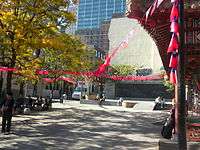
Overseas Chinese played a key role in the birth of the ROC since the nation’s founding father Sun Yat-sen, a medical doctor by training, received financial support mainly from the overseas Chinese communities abroad to overthrow the imperial Qing dynasty and establish the second republic in Asia in 1912. Outside of Taiwan, the National Day is also celebrated by many Overseas Chinese communities. Sizable National Day parades occur yearly in the Chinatowns of San Francisco and Chicago.
Hong Kong
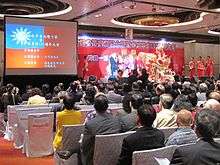
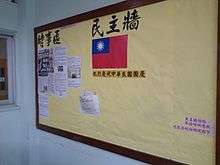
The ROC National Day was a public holiday in Hong Kong until the government of the United Kingdom cut its diplomatic ties with the ROC Government, and it was cancelled.[5] After the civil war in mainland China, the National Day was celebrated in regions inhabited by Chinese patriots who remained loyal to the Republic, such as Tiu Keng Leng. Before the sovereignty of Hong Kong was transferred to the PRC in 1997, many ROC supporters there would display patriotic and colorful flags (mainly the national flag of ROC) to celebrate the National Day. Taiwan agencies such as the Kwang Hwa Information and Cultural Center in Hong Kong have annually held a public ceremony to celebrate the National Day of ROC with members of pro-ROC private groups.[6] The day continues to be celebrated in Hong Kong after the transfer of sovereignty to the mainland, but the national flags publicly shown have been removed by Police of Hong Kong ever since July 1997.[7] Flag-raising ceremony at Hung Lau, Tuen Mun, Sun Yat-sen's revolutionary base, is the most noticeable event.
Mainland China
As the Communist Party of China seized control of mainland China in 1949, October 10 is now celebrated in the People's Republic of China as the anniversary of the Xinhai Revolution and the Wuchang Uprising.
See also
- History of the Republic of China
- 10/10/1943 uprising against the Japanese occupation of British Borneo
- Hong Kong 1956 riots
- Double Tenth Agreement
References
- ↑ 紀念日及節日實施辦法
- ↑ 國民中小學九年一貫語文科課程綱要英語科, p149, 22
- ↑ 10 October 2011, Skydiving show wows crowds on National Day, Focus Taiwan news
- ↑ Cindy Sui, 10 October 2011, Legacy debate as Republic of China marks 100 years, BBC News
- ↑ Far Eastern Economic Review, 1968, page 450
- ↑ Sinorama
- ↑ 香港移交後之爭議事件
External links
| Wikimedia Commons has media related to National Day of the Republic of China. |
- Republic of China Centenary Foundation (Taiwanese Mandarin)